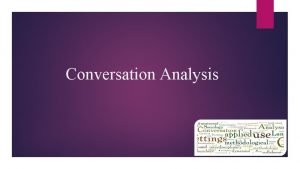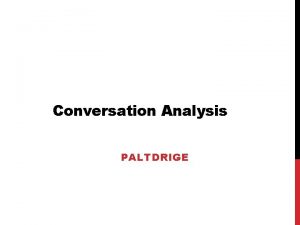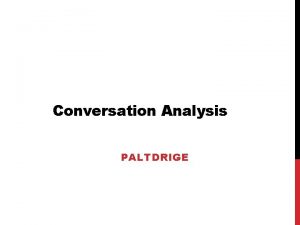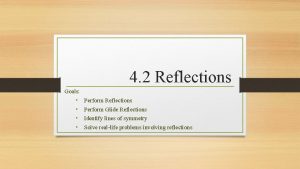The LanguageAction Model of Conversation Can conversation perform












- Slides: 12

The Language/Action Model of Conversation: Can conversation perform acts of design? Peter H. Jones Vivek Tyagi 324004932

A Conversion about conversion • What are the context of conversation? – Two individuals talking with each other. • Cherry – “It is exchange of normatively defined meanings and creating understanding between purposeful social participants. ” • Particular exchange b/w people, representing individual interests or intentions, or collective interests represented by individuals. • Phatic conversation – “Small talk”

Conversations in design • Conversations for design must reflect and preserve the positions and contributions of multiple participants included in the model of change. • Three orientations which guide participation in very different ways – Rational perspective – Pragmatic perspective – Phenomenological perspective

Rational Perspective • Instrumental and purposive individual communications systems • To achieve sophisticated design outcomes. • Facilitates relationship between designers, stakeholders, and product or material • Mainstream perspective in our technological culture.

Pragmatic Perspective • Considers design an inherently communicative practice • Unique coupling of appropriate language to the design situation is created • Stakeholders and their lifeworlds are followed rather than promoting our own language of design.

Phenomenological perspective • Acknowledges all meanings arises in language. • Human activity is not separate from language • Conversation is not a tool for outcomes, rather language uses us, shaping and constraining our work and experience

Three Orientations

Types of Speech Acts • Five basic acts: – Assertives: commit a speaker to the truth of an expression – Directives: requests, commands and advice – Commissives: promises and oaths – Declarations: change the circumstances of reality to accord with a proposition (e. g. , pronounce couple as married) – Expressives: convey a speaker’s attitudes or emotions about a proposition (e. g. , praise)

Speech Acts

Types of purposeful conversations • Orientation: It is maintained by conversation that mutually regards a shared referent object (e. g. , the weather). Intent is merely acknowledgement • Possibility: It includes interpersonal queries, inquiries and propositions that “open a context”. Goal is the construction of understanding and novelty • Action: When opening affords the potential for action, Conditions may include some agreed outcome, and agreements about necessary quality and future dates.

Conclusion • Web-based systems have greatly enabled the ability to collaborate, people are easily overloaded by multiple communication channels • Managing commitment and attention remains the weak link in our technology panorama. • A conversation design perspective can enhance our coordination of attention as well as action. • Finally, the emerging perspective of purposive design— “designing for” (e. g. sustainability, thrivability, transformation, care)—shares an ontological basis with “conversation for” in terms of intentionality and social teleology

Thank You
 Composition of functions perform the indicated operation
Composition of functions perform the indicated operation Conversation conversation
Conversation conversation Hát kết hợp bộ gõ cơ thể
Hát kết hợp bộ gõ cơ thể Lp html
Lp html Bổ thể
Bổ thể Tỉ lệ cơ thể trẻ em
Tỉ lệ cơ thể trẻ em Voi kéo gỗ như thế nào
Voi kéo gỗ như thế nào Thang điểm glasgow
Thang điểm glasgow Chúa yêu trần thế
Chúa yêu trần thế Các môn thể thao bắt đầu bằng từ đua
Các môn thể thao bắt đầu bằng từ đua Thế nào là hệ số cao nhất
Thế nào là hệ số cao nhất Các châu lục và đại dương trên thế giới
Các châu lục và đại dương trên thế giới Công của trọng lực
Công của trọng lực























